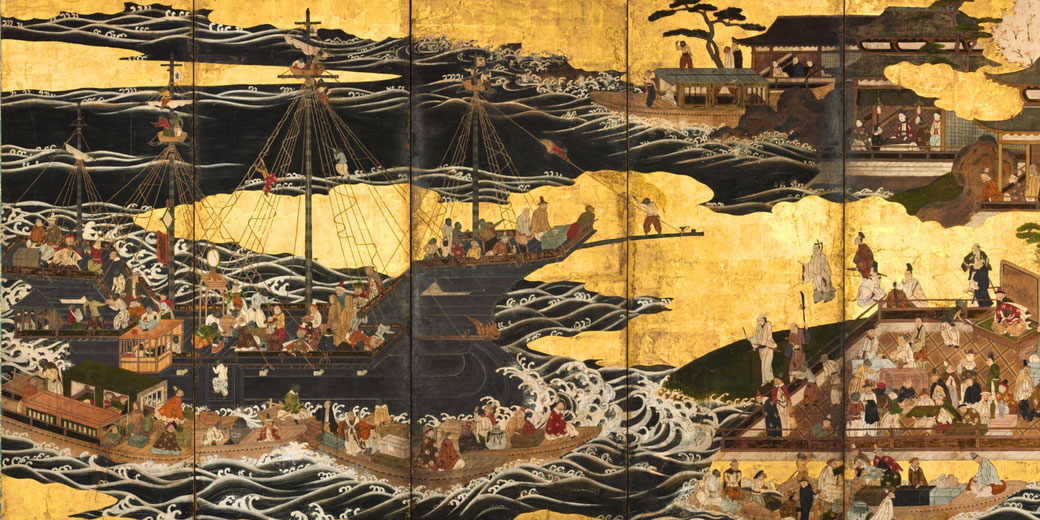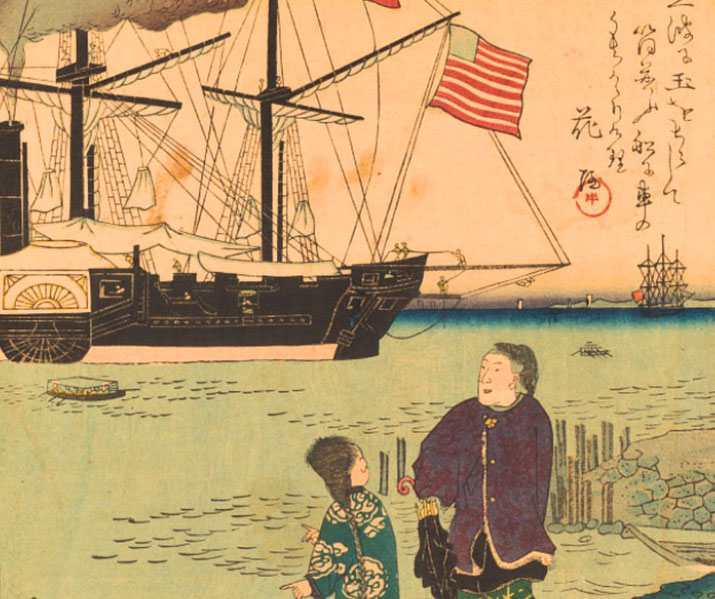The dramatic end to shogunate Japan

In 1853, the arrival of Commodore Perry and his Black Ships from the United States of America changed the course of history for Japan.
This event marked the beginning of the end for the Tokugawa shogunate, which had ruled Japan for over 250 years.
The shogunate was abolished in 1868 when imperialist loyalists defeated its forces and restored power to the emperor.
Both internal and external factors led to the collapse of the shogunate and the establishment of the Meiji era, which marked a new era of modernisation and Westernisation in Japan.
Background
Japan in the 19th century was an isolated country and the Tokugawa shogunate, also called bakufu, meaning "tent government", tried to keep it that way by restricting trade with other nations.
The Tokugawa bakufu was a feudal military dictatorship established in 1603 and led by the Tokugawa clan until 1868.
It was founded when Tokugawa Ieyasu became the ruler of Japan after defeating the Toyotomi clan in the Battle of Sekigahara in 1600.
The Tokugawa shogunate lasted for over 250 years and instituted the policy of sakoku, meaning "closed country”, which was a period of isolation from most of the world. This isolated Japan for more than 200 years.

Arrival of the Americans
Perry had a fleet of four Black Ships and arrived at Edo Bay (Tokyo) in 1853.
The Perry Expedition was sent by the US government to Japan in order to get Japan to sign a treaty that would allow the US access to Japanese ports.
The bakufu's response was reluctant and they used delaying tactics but eventually representatives from the emperor met with Perry and accepted the letter which the US President had sent.
The letter did not contain a treaty but proposed that “the United States and Japan should live in friendship” and suggested the emperor “change the ancient laws as to allow a free trade between the two countries".
Perry told the representatives that he would return the following year to receive a reply from Japan.

The Treaty of Kanagawa
The bakufu did not want the US to dominate Japan and it knew about the threat an "overseas barbarian" country could pose.
It was given permission by Emperor Kōmei (1831-1867) to sign a treaty that would allow the United States limited access to two ports in Japan.
The Treaty of Kanagawa was signed on 31 March 1854, and it marked the beginning of Japan's opening to the world.
In particular, the treaty allowed the US to establish a consulate in Japan. The treaty also stated that any citizens of the United States, including shipwrecked men, would be allowed to live freely at the ports without restrictions or confinement.
Harris Treaty
A further treaty was signed on 29 July 1858, which allowed access to more ports and greater opportunities for trade between the two countries.
The Treaty of Amity and Commerce is the official name, but it is more widely known as the Harris Treaty, after Townsend Harris, who was the first US consul in Japan.
This treaty also established extraterritoriality rights for foreigners in Japan, which meant that foreigners were not subject to Japanese law and could only be tried by their own country's laws.
It also gave US nationals living in the Japanese treaty ports the right to express their Christian religion.
Adopting Western ideas
The bakufu realised it could not stop foreigners from coming to Japan and decided to study Western technology and ideas.
It started to send students, known as rangaku scholars, to study in the Netherlands and other European countries.
These scholars were instrumental in introducing Western technology and knowledge to Japan.
Japan was exposed to new forms of government, technology, and education, and quickly realised the benefits of incorporating these into their own society.
The bakufu also decided to import weapons from the West in order to defend itself against possible attacks by foreigners.
However, not everyone in Japan was happy with the influence of the West and it led to civil unrest and conflict.
This period of time from 1853 to 1868 is called the bakumatsu , which means "end of bakufu”.
The Boshin War and the end of bakufu
The bakumatsu period was a time of profound change and transition as Japan faced growing pressures from foreign powers, exposure to Western ideas and technology, and internal conflicts and tensions.
During this time, the ruling Tokugawa shogunate faced challenges from various factions within Japanese society, including imperial loyalists, reformists, and those who saw the shogunate as a hindrance to Japan’s modernisation and national unity.
Many samurai were unhappy with the bakufu's decision to open up Japan to foreigners.
They felt that it was a betrayal of the country and it had led to significant economic disruptions which weren’t being addressed.
They decided to overthrow the bakufu, which led to the Boshin war in 1868.
The Boshin War was led by samurai from the Chōshū and Satsuma domains, which were two of the most powerful domains in Japan, who attacked shogunate forces in Tokyo.
Following the Battle of Hakodate in 1869, the bakufu was defeated and the emperor was restored to power.
The Tokugawa shogunate was abolished and replaced by a new government, which was later called the Meiji Restoration.
Why did the shogunate fall?
The downfall of the Tokugawa shogunate was brought about by a combination of internal and external factors.
Domestically, there was growing discontent with the shogunate's corrupt and ineffective governance, which led to demands for political and social reform.
Internationally, Japan was facing increasing pressure from foreign powers, particularly from the West, which sought greater access to Japan's economy and resources.
This, along with the shogunate's military weakness and financial instability, contributed to the decline of the shogunate.
The arrival of American Commodore Perry in 1853 was a wake-up call, demonstrating the shogunate's inability to defend Japan against foreign threats and highlighting the need for modernisation.
The fall of the shogunate paved the way for the Meiji era (1868-1912), during which Japan underwent a period of rapid modernisation and Westernisation.
The Meiji era is known for its significant political, economic, and social reforms, including the abolition of the samurai class, the establishment of a constitutional monarchy, and the introduction of Western-style institutions and technologies.
What do you need help with?
Download ready-to-use digital learning resources
Copyright © History Skills 2014-2025.
Contact via email
With the exception of links to external sites, some historical sources and extracts from specific publications, all content on this website is copyrighted by History Skills. This content may not be copied, republished or redistributed without written permission from the website creator. Please use the Contact page to obtain relevant permission.





